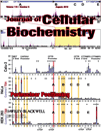
ARCHIVES OF PHYSIOLOGY AND BIOCHEMISTRY
Scope & Guideline
Connecting Biochemical Insights to Physiological Functions
Introduction
Aims and Scopes
- Metabolic and Endocrine Physiology:
Research exploring the mechanisms of metabolic regulation, hormonal influences on metabolism, and their implications for diseases such as diabetes and obesity. - Oxidative Stress and Antioxidant Defense:
Studies investigating the roles of oxidative stress in cellular damage and disease progression, along with the effects of various antioxidants in mitigating these processes. - Inflammation and Immune Responses:
Research focused on the inflammatory pathways involved in chronic diseases, particularly how they relate to metabolic syndromes and cardiovascular conditions. - Pharmacological Interventions and Natural Products:
Exploration of pharmacological agents and natural compounds for their therapeutic effects on various metabolic and degenerative diseases. - Animal Models in Disease Research:
Utilization of animal models to understand disease mechanisms, test new therapies, and study the physiological and biochemical changes associated with various conditions. - Molecular and Cellular Mechanisms:
Research detailing molecular pathways involved in disease processes, including signaling pathways that regulate cellular functions related to metabolism and health.
Trending and Emerging
- Diabetes and Metabolic Syndrome Research:
A significant increase in studies focused on diabetes, insulin resistance, and metabolic syndrome reflects the growing public health crisis associated with these conditions. - Role of Non-coding RNAs in Disease:
Emerging research on non-coding RNAs, such as lncRNAs and microRNAs, highlights their regulatory roles in various diseases, particularly in metabolic and cardiovascular contexts. - Impact of Gut Microbiota on Metabolism:
An increasing focus on the relationship between gut microbiota and metabolic health, exploring how gut health influences systemic metabolic processes. - Therapeutic Effects of Natural Products:
There is a rising trend in investigating the therapeutic potentials of natural compounds and herbal extracts, emphasizing their role in disease prevention and management. - Oxidative Stress and Inflammation Interplay:
Research increasingly explores the interplay between oxidative stress and inflammation in chronic diseases, highlighting their combined effects on health outcomes.
Declining or Waning
- Traditional Dietary Supplements:
Interest in conventional dietary supplements has decreased, as research shifts towards more innovative and targeted therapies for metabolic disorders. - Basic Biochemical Pathways without Clinical Relevance:
Research focusing solely on fundamental biochemical pathways without clear clinical implications is less frequently published, as the journal now emphasizes studies with direct relevance to health and disease. - General Reviews of Common Diseases:
There is a noticeable reduction in general review articles that do not provide new insights or innovative approaches, reflecting a preference for more specific and novel research contributions.
Similar Journals

JOURNAL OF CELLULAR BIOCHEMISTRY
Delivering Impactful Findings in Biochemistry and Cell BiologyJournal of Cellular Biochemistry is a premier academic journal dedicated to advancing the field of biochemistry and cellular biology. Published by Wiley, this influential journal has a significant impact factor that underscores its relevance and authority within the scientific community. With its ISSN 0730-2312 and E-ISSN 1097-4644, the journal has been on the frontier of research since its inception in 1982, and is expected to continue publishing cutting-edge studies through 2024. As evidenced by its ranking in the 2023 Scopus Quartiles, it holds a rank of Q2 in Biochemistry and Q3 in both Cell and Molecular Biology, placing it among the top tiers of scientific journals in these disciplines. The Journal of Cellular Biochemistry serves as a vital resource for researchers, professionals, and students alike, providing a platform for the dissemination of innovative ideas and findings that shape our understanding of cellular processes and biochemical pathways. Though it does not currently offer Open Access options, its robust peer-review process ensures that each publication meets the highest academic standards, thus solidifying its esteemed position in the landscape of biochemical research.

International Journal of Biological Sciences
Pioneering Discoveries in Biological ResearchInternational Journal of Biological Sciences (ISSN: 1449-2288, E-ISSN: 1449-2288) is a premier open-access journal published by IVYSPRING INTERNATIONAL PUBLISHING since 2005, located in Australia. With a commitment to advancing knowledge in the life sciences, this journal covers a wide spectrum of disciplines, including Applied Microbiology and Biotechnology, Cell Biology, Developmental Biology, Ecology, Evolution, Behavior and Systematics, and Molecular Biology, earning a distinguished Q1 ranking in these fields as of 2023. It stands out with exceptional Scopus rankings, placing in the top ranks across multiple categories, such as the 98th percentile in Ecology, Evolution, Behavior and Systematics and the 94th percentile in Applied Microbiology and Biotechnology. The journal fosters an open access philosophy, ensuring that research findings are readily available to the scientific community and the public, and invites original research articles, reviews, and commentaries. With its mission to disseminate high-quality research, the International Journal of Biological Sciences serves as an essential resource for researchers, professionals, and students seeking to deepen their understanding and drive innovation in biological sciences.

CELLULAR PHYSIOLOGY AND BIOCHEMISTRY
Pioneering Insights into Cellular ProcessesCellular Physiology and Biochemistry is a premier Open Access journal published by the prestigious Cell Physiol Biochem Press GmbH & Co, dedicated to advancing research in the fields of physiology, biochemistry, and molecular biology. Since its inception in 1987 and transitioning to an Open Access model in 2013, the journal has established itself as a vital resource for the dissemination of high-quality research and reviews, showcasing innovative methodologies and groundbreaking findings in cellular processes. With an impressive ranking in the 2023 Scopus category as Q2 in Physiology and a robust percentile of 61, Cellular Physiology and Biochemistry is committed to fostering academic dialogue among researchers, professionals, and students alike. This journal not only provides unrestricted access to its articles, but also promotes the global sharing of knowledge, which is essential for the advancement of our understanding in these vital scientific areas. The journal's editorial team is dedicated to ensuring the highest standards of academic rigor and relevance, making it an indispensable addition to the libraries of those engaged in the life sciences.

Physiology and Pharmacology
Catalyzing discoveries in physiology and pharmacology.Physiology and Pharmacology is a distinguished open access journal that has been disseminating high-quality research in the fields of physiology and pharmacology since its inception in 1997. Published by the Iranian Society of Physiology & Pharmacology, this journal offers a platform for scholars and practitioners to share innovative findings and advancements that contribute to the understanding of biological systems and drug action. With its ISSN 2476-5236 and E-ISSN 2476-5244, it ensures global reach and accessibility. The journal is positioned in the third quartile for Linguistics and Language and fourth quartile in both Pharmacology and Physiology categories according to Scopus rankings, reflecting a commitment to expanding knowledge within these interdisciplinary domains. Set within the academic landscape of Iran, the journal aims to bridge regional research with the international community, providing valuable insights into physiological processes and pharmacological developments. In light of its open access model, the Physiology and Pharmacology journal plays a crucial role in enhancing the visibility of research outcomes and fostering collaboration among researchers, professionals, and students on a global scale.

HORMONE AND METABOLIC RESEARCH
Driving Innovation in Endocrine and Metabolic StudiesHORMONE AND METABOLIC RESEARCH, published by GEORG THIEME VERLAG KG, stands as a reputable platform in the fields of biochemistry, endocrinology, and metabolism since its establishment in 1969. This peer-reviewed journal provides critical insights and advancements in the intricate relationships between hormones and metabolic processes, catering to researchers, healthcare professionals, and students alike. With an impressive convergence of knowledge spanning over five decades, it maintains a commendable Q3 ranking in multiple categories, including Biochemistry, Clinical Biochemistry, and Endocrinology, highlighting its contribution to cutting-edge scientific discourse. Although not an open-access journal, it offers a plethora of access options for readers and institutions, ensuring that vital research reaches those who need it most. Located in Stuttgart, Germany, the journal is positioned at the forefront of influential research in hormone and metabolic studies, emphasizing its importance for ongoing investigations into health and disease.

Correspondances en Metabolismes Hormones Diabetes et Nutrition
Fostering Collaboration in Diabetes and Nutrition ResearchCorrespondances en Metabolismes Hormones Diabetes et Nutrition is a vital resource for researchers and practitioners in the fields of endocrinology, diabetes, and nutrition, published by EDIMARK SANTE in France. Established since 2009, this journal diligently focuses on the evolving relationship between metabolic processes and hormonal regulation, catering to the interdisciplinary nexus of food science and medicine. Although currently classified in the Q4 quartile for 2023 in its respective categories, the journal remains significant for its contributions to understanding metabolic disorders and nutritional impacts on health. With the growing global obesity epidemic and increasing diabetes prevalence, the journal aims to disseminate cutting-edge research, case studies, and reviews that will foster discussion and prompt innovation in treatment and dietary strategies. While it follows a traditional publishing model, its aim is to enhance accessibility to critical findings for a wide audience, from corporate researchers to clinical practitioners and students seeking in-depth knowledge in this crucial area.

ACTA BIOCHIMICA ET BIOPHYSICA SINICA
Illuminating Pathways in Biomedical Research with Insightful Articles.ACTA BIOCHIMICA ET BIOPHYSICA SINICA, an esteemed journal published by SCIENCE PRESS, is a leading platform in the fields of biochemistry, biophysics, and molecular biology. Based in the United Kingdom, this journal has consistently ranked in the Q2 category for Biochemistry, Biophysics, and Medicine (miscellaneous) in 2023, showcasing its commitment to high-quality research and innovation in life sciences. With a convergence period extending from 1996 to 2024, it features critical insights into biochemical and biophysical processes that underlie biological phenomena. Researchers and professionals seeking to stay at the forefront of discoveries will find its articles to be both informative and transformative. Although not an open-access journal, ACTA BIOCHIMICA ET BIOPHYSICA SINICA aims to advance knowledge and foster collaboration among scientists worldwide, emphasizing its role in the dynamic landscape of biomedical research.

INTERNATIONAL JOURNAL OF BIOCHEMISTRY & CELL BIOLOGY
Illuminating the Path of Biochemical ExplorationThe International Journal of Biochemistry & Cell Biology, published by Pergamon-Elsevier Science Ltd, stands as a pivotal resource in the fields of biochemistry and cell biology. With an ISSN of 1357-2725 and an E-ISSN of 1878-5875, this prestigious journal has been a key platform for disseminating cutting-edge research since its inception in 1995. The journal currently holds an impressive Q1 ranking in Biochemistry and a Q2 ranking in Cell Biology for the year 2023, reflecting its commitment to high-quality research and its influence within the scientific community. With a significant Scopus ranking of 94/438 in Biochemistry and 96/285 in Cell Biology, the journal plays a crucial role in advancing knowledge and fostering innovative approaches in these dynamic fields. Though it is not an open-access journal, the International Journal of Biochemistry & Cell Biology remains accessible to a wide audience, making it a vital resource for researchers, professionals, and students alike, who are eager to explore and contribute to the ongoing advancements in biochemistry and cell biology.

CELLULAR SIGNALLING
Advancing the Frontier of Cellular MechanismsCELLULAR SIGNALLING, published by Elsevier Science Inc, is a premier journal within the realm of Cell Biology, boasting an impressive Q2 category ranking as of 2023. With an ISSN of 0898-6568 and an E-ISSN of 1873-3913, the journal has established itself as a critical platform for advancing the understanding of cellular mechanisms and signal transduction pathways since its inception in 1989. Covering a vast array of topics in Biochemistry, Genetics, and Molecular Biology, it ranks notably at 87 out of 285 in the Scopus list, placing it in the 69th percentile among its peers. The journal serves as an invaluable resource for researchers, professionals, and students seeking high-quality, impactful studies that drive forward the field of cellular biology. While it operates under traditional subscription access, its highlights include rigorous peer-reviewed articles, reviews, and insights that continue to shape current scientific discourse.

BIOCHEMICAL AND BIOPHYSICAL RESEARCH COMMUNICATIONS
Advancing the frontiers of biochemistry and biophysics.BIOCHEMICAL AND BIOPHYSICAL RESEARCH COMMUNICATIONS, published by Academic Press Inc Elsevier Science, stands as a leading periodical in the fields of biochemistry, biophysics, cell biology, and molecular biology. With an ISSN of 0006-291X and an E-ISSN of 1090-2104, this esteemed journal has been a pivotal platform for the dissemination of groundbreaking research since its inception in 1959, continuing to publish influential findings through at least 2024. It holds a commendable Q2 ranking in Biochemistry and Q1 status in Biophysics as of 2023, reflecting its high impact and relevance in the field, supported by its strong Scopus rankings—ranking #43 in Biophysics and maintaining a presence in the top quartiles of several related categories. Although it is not an open-access journal, it provides critical insights and essential data that cater to researchers, professionals, and students keen on advancing their understanding of complex biochemical and biophysical processes. Its significant contributions to the scientific community underscore the importance of this journal as a reference point for innovative research and collaborative discourse.